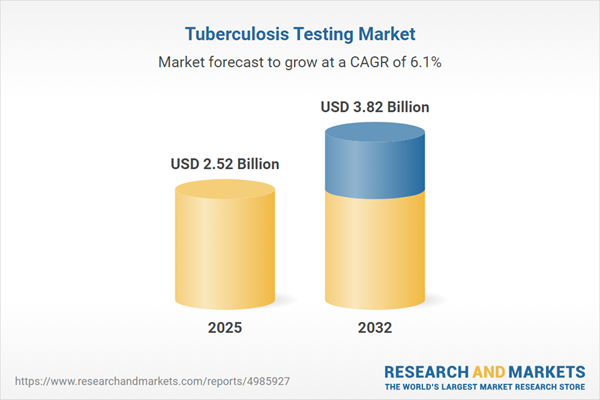Speak directly to the analyst to clarify any post sales queries you may have.
Senior healthcare executives face a rapidly changing tuberculosis testing market, where demands for accurate diagnosis, evolving regulations, and innovation in diagnostics require informed, agile decision-making to ensure operational excellence and sustained organizational growth.
Tuberculosis Testing Market Snapshot
The global tuberculosis testing market is valued at USD 2.38 billion in 2024 and projected to reach USD 2.52 billion by 2025, with a 6.10% compound annual growth rate (CAGR) through 2032 and an expected value of USD 3.82 billion at the forecast's end. This steady growth trajectory is supported by major advances in next-generation assay platforms and flexible diagnostic solutions. Healthcare organizations are prioritizing reliable testing workflows and scalable, automated compliance processes that reinforce their resilience and adaptability. Strategic emphasis on these components is shaping the competitive landscape, with regulatory shifts and regional challenges further influencing procurement and deployment strategies.
Scope & Segmentation of the Tuberculosis Testing Market
This report equips senior leaders with actionable insight into procurement and adoption strategies for tuberculosis diagnostics. The segmentation approach aligns with diverse healthcare environments and evolving operational needs for well-informed planning and resource allocation.
- Test Types: Includes culture-based methods, immunological assays, PCR, line-probe assays, molecular diagnostics, and rapid diagnostic kits—each tailored to varying clinical and logistical requirements.
- End Users: Hospitals, clinics, and reference laboratories, each with distinct patient management needs and resource deployment models.
- Technologies: Encompasses immunodiagnostics, traditional culture techniques, rapid diagnostic solutions, and nucleic acid amplification, allowing diverse operational approaches.
- Sample Types: Utilizes blood, sputum, and urine samples to ensure flexibility across patient groups and care settings.
- Distribution Channels: Diagnostic laboratories, hospital pharmacies, and digital logistics support regulatory compliance and efficient supply chains.
- Applications: Covers both active and latent tuberculosis detection, facilitating integrated healthcare delivery and public health objectives.
- Regions: Spans the Americas, Europe, Middle East & Africa, and Asia-Pacific, reflecting differences in regulations, infrastructure, and healthcare priorities.
- Leading Companies: Key innovators include Cepheid, QIAGEN, Hain Lifescience, Roche Diagnostics, Abbott Laboratories, Becton Dickinson, Bio-Rad, Thermo Fisher Scientific, Siemens Healthineers, and bioMérieux, whose offerings shape global standards and influence market access.
Key Takeaways for Senior Leaders
- Adoption of molecular and point-of-care technologies streamlines diagnostic workflows and enables faster clinical decisions in diverse institutions.
- AI integration and cloud-based systems promote standardized test access and bridge service gaps in remote or under-resourced locations.
- Advances in microfluidic diagnostics support expansion of testing programs and result in greater affordability across broad populations.
- Partnerships among manufacturers, provider networks, and regulatory bodies enhance supply chain stability and support smooth clinical transitions.
- Progress with biomarker and genome-editing technologies increases diagnostic precision and underpins earlier case identification, benefitting patient care strategies.
- Implementation of robust analytics platforms drives harmonized test management and ensures reproducibility in high-volume laboratory operations.
Tariff Impact: Navigating U.S. Trade Measures
Recent U.S. tariffs on imported diagnostics have motivated healthcare organizations to reexamine supply chain options and invest in domestic solutions. Senior leaders are adopting diversified sourcing models and diagnostic platforms to reduce exposure to trade disruptions. Strategic collaboration with industry stakeholders and regulators also bolsters compliance and operational continuity amid shifting trade landscapes.
Methodology & Data Sources
This report draws on established secondary research and direct validation with laboratory specialists, healthcare executives, and public health authorities. Findings align with current regulatory standards and offer actionable intelligence to support strategic decisions in tuberculosis testing.
Why This Report Matters
- Offers senior leadership a clear overview of tuberculosis testing options in line with emerging technology trends and compliance pressures.
- Supports data-driven decision making and targeted risk mitigation across evolving operational settings, helping organizations secure long-term resilience.
- Guides development of robust testing programs focused on enhancing clinical outcomes and operational efficiency across the tuberculosis landscape.
Conclusion
This report empowers senior decision-makers to advance tuberculosis diagnostic programs, align with regulatory and operational demands, and maintain consistent, high-quality testing as part of strategic and patient-centered organizational growth.
Additional Product Information:
- Purchase of this report includes 1 year online access with quarterly updates.
- This report can be updated on request. Please contact our Customer Experience team using the Ask a Question widget on our website.
Table of Contents
3. Executive Summary
4. Market Overview
7. Cumulative Impact of Artificial Intelligence 2025
Companies Mentioned
The companies profiled in this Tuberculosis Testing market report include:- Cepheid, Inc.
- QIAGEN N.V.
- Hain Lifescience GmbH
- Roche Diagnostics International Ltd
- Abbott Laboratories
- Becton Dickinson and Company
- Bio-Rad Laboratories, Inc.
- Thermo Fisher Scientific Inc.
- Siemens Healthineers AG
- bioMérieux SA
Table Information
| Report Attribute | Details |
|---|---|
| No. of Pages | 197 |
| Published | November 2025 |
| Forecast Period | 2025 - 2032 |
| Estimated Market Value ( USD | $ 2.52 Billion |
| Forecasted Market Value ( USD | $ 3.82 Billion |
| Compound Annual Growth Rate | 6.1% |
| Regions Covered | Global |
| No. of Companies Mentioned | 11 |









